
Edward Grey Surgeon. Born about 1745
Married Jane Campbell 4 Feb 1777
Died at Heton. Buried at Ford 5 March 1822
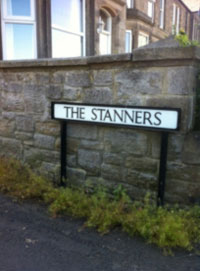
Edward Grey’s father was John of Longhorsley. He was born about 1745, possibly at Longhorsley but he is not recorded there with his other siblings. Edward was mentioned in the wills of his father John in 1779 and of his brother William.
One of the rare Greys not to have become a farmer he must have been well educated and also trained in order to become a surgeon. Possibly he trained at Edinburgh, which would have been the nearest place. He is the first to be mentioned in his father’s will which may mean that he was the eldest and possibly the reason why he was given an education, which would have been expensive.
He married Jane Campbell in Alnwick on 4 February 1777. Their son Henry was born in Alnwick on 11 February 1778. Edward is recorded as working as a medical practitioner in Alnwick in the biography of his son.
According to the Dictionary of National Biography, his wife left him very early on taking their son Henry with her to bring him up in Edinburgh.
Edward's father’s will written on 24 November 1778 says: “ I leave and bequeath to my well beloved son Edward Grey all my Freehold piece of land containing Eight acres lying on Tyne Side in Corbridge known by the name of Stanners With all Deeds and appurtenances thereunto belonging to him and his Heirs forever”
Edward is said to be of Morpeth, and is described as a surgeon in 1792 by his brother William. He died at Heton, possibly having returned to live with his nephew John, son of his brother John, because the other members of his family had predeceased him. Possibly if his wife had left him he was estranged from his son as well. He lived the longest of all his siblings. He was buried on 5 March 1822 aged 77 according to the registers at Ford, which are given as a source on the Milfield family tree. His only son Henry went on to become a clergyman.
View Greys in Northumberland in a larger map

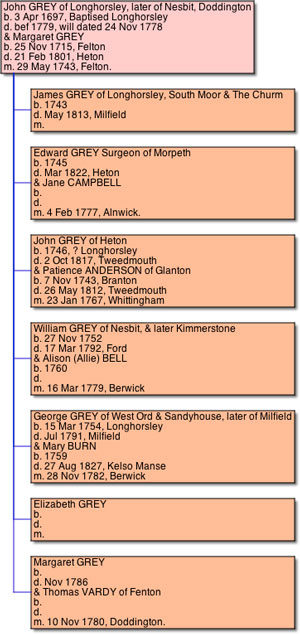

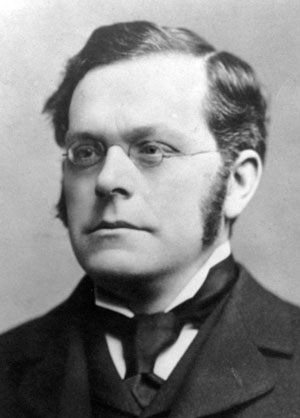
Henry and Margaretta's daughter Harriet Jane was born on 24 July 1811. She married Charles Mitchell Birrell in Edinburgh on 8 March 1838. Charles, born in Scotland was a Baptist Minister and they can be found on the 1851 census living at 135, Olive Lane in Wavertree, Liverpool, where he was minister at Pembroke Chapel. They had five children: Henry Grey 13, Charles Howe, 11, Harriet Eliza, 6, Mary Olive, 3 and Augustine 1 and three servants, a cook, a nurse and an under nurse.
By 1861 they had moved to 18 Duke Street North, Liverpool, four of the children were living with Harriet, she was still married to Charles who continued to be the Minister at Pembroke Chapel. Henry Grey Birrell, 23, was a commercial clerk, while the others were all at school. Emily Grey Birrell, 15 Mary Olive, 13 and Augustine aged 11. They had two house servants. Henry Grey Birrell became a banker retiring to Hove in 1901.
Harriet Jane died in October 1863 at the age of 52 and Charles died in 1880 at the age of 69.
An online family tree has the following:
4. Rev. John Hampden GURNEY. Born on 15/8/1802 in 12 Sargeants Inn, Fleet Street, London, England. John Hampden died in 63 Gloucester Place, Portman Square, London, England on 8/3/1862, he was 59. Occupation: Minister of the Church of England. Education: Chobham School; Trinity College, Cambridge.
On 24/10/1839 when John Hampden was 37, he married Maria GREY, daughter of Rev Henry GREY & Margaretta GREY, in Edinburgh, Midlothan, Scotland. Maria died in 1857.
They had the following children:
i. Frederick. Born in 1842 in Lutterworth, Leics, England.
ii. Emily. Emily died in 12/1875 in Egypt.
7 iii. Alfred (1844-1898)
iv. Ellen Mary. Born abt 1846 in London, England. Ellen Mary died in The Close, Salisbury, Wilts, England on 25/3/1908, she was 62. Christened on 24/6/1846 in St Martin in the Fields, Westminster, London, England.
8 v. Edmund (1847-1888)
vi. John Henry. Born on 19/6/1849 in London, England. John Henry died in Repton, Derbys, England on 26/1/1919, he was 69. Occupation: Science Teacher; Assistant Master Repton School (1881). Education: Repton; Trinity College, Cambridge.After 3/4/1881 John Henry married Fanny Harriet [--?--]. Fanny Harriet died aft 24/1/1919. No known children
vii. Rosamund. Born on 28/2/1851. Rosamund died in Egypt in 12/1875, she was 24.
viii. Henry Grey. Born on 19/12/1852 in London, England. Henry Grey died in The Priory, Roehampton, Surrey, England on 7/1/1896, he was 43. Occupation: West Indian Merchant (1881).
ix. Mary. Born on 21/6/1854. Mary died in Egypt in 12/1875, she was 21.
x. Hampden. Born on 16/6/1857.
The family can also be found on the Peerage website here, and a book about Edmund Gurney here.
Three of the daughters were drowned in the Nile (2) and the tenth child died at only a few weeks old. Mary may have died at his birth.

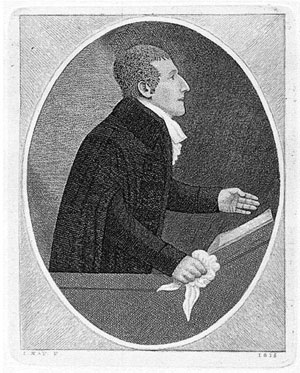
"DEATH OF THE REV. OF C.M. BIRRELL We regret to announce the death of the Rev. Charles Mitchell Birrell, which took place at his residence, Elliott Place, Blackheath last evening. This information will be received with deep regret in Nonconformist circles in this city, where the deceased laboured as a minister of the Baptist denomination for a period of thirty-four years, during which time he gained the goodwill and esteem of all with whom he came in contact. Mr. Birrell began his ministry in a quaint old chapel in Byrom Street, now known as Byrom Hall, in the year of 1836; but the accommodation there proved insufficient and by the liberality and enterprise of the congregation Pembroke Chapel was built and opened in 1839. The ministrations of the rev. gentlemen were marked by great success, and he entered with great spirit into the work of establishing sister churches in Birkenhead, Bootle and Everton, in addition to the immediate duties of his pastorate, which were invariably attended to most zealously. He continued as the minister of Pembroke Chapel until nearly the end of the year 1872, when, in consequence of failing health he tended his resignation to the congregation of the church. The feeling of the congregation was shown by their earnest entreaties that he would continue to be the pastor in conjunction with another, but to this request he declined to accede from convictions of duty. The members of the church then set about making some recognition of their appreciation of the services of the pastor, a scheme in which they were readily assisted by outside friends; and the result was that £2, 620 were subscribed, which sum was presented to Mr. Birrell, together with an illuminated address, in December, 1872, when he took a partial farewell of his congregation. He continued to reside in the town for some time after the appointment of his successor, the Rev. P.G. Scorey (who has since resigned), but subsequently took up his residence in London, where he remained until his death." Friday 17 December 1880 , Liverpool Echo
His death certificate records that he was living at 12 Elliot Place, Blackheath at the time of his death. He is buried at Norwood cemetery in Lambeth.
Henry's marriage is not mentioned in the Dictionary of National Biography, but he did marry his first cousin Margaretta Grey daughter of George Grey of West Ord and later Milfield on 12 October 1808 according to the registers of Kirknewton.
Margaretta was an exceptional woman who dressed up as a boy in order to listen to the debates in the House of Commons. Margaretta died at the age of 69 but Henry lived till he was 80. He died at 5 East Claremont Street Edinburgh 13 Jan 1859.
Henry and Margaretta had five children, all born in Scotland: three daughters and two sons according to a biographical sketch of Henry.
Henry and Margaretta's son the Reverend Edward John Grey lived at Etherly, Durham in 1859 and was a curate at Long Eaton Derbyshire in 1861. He died at Harworth, Nottingham in 1869 , unmarried at the early age of 49.
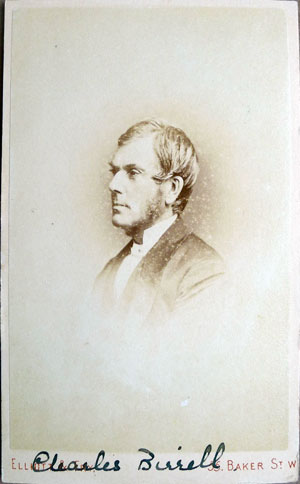
Charles Birrell photographed in the studio of Elliot and Fry, 55 Baker Sreet, Portman Square, London. Photo from Josephine Butler archive, the LSE Library collections. Ref 3AMS/G/04/025
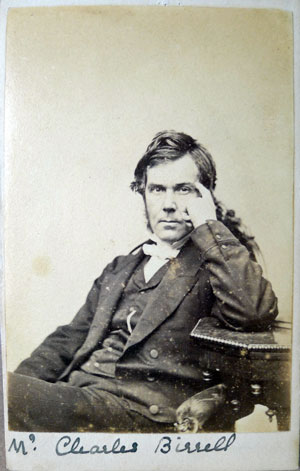
Charles Birrell photographed in the studio of J. Lee, at 57 Church Street, Liverpool.
Photo from the Josephine Butler archive, LSE Library collections. Ref 3AMS/G/04/026
Notes.
(1) The two Grey/Gurney Marriages. Henry Grey and Margaretta Grey were first cousins their daughter Mary married John Hampden Gurney while their son Henry Campbell Grey married Maria Gurney d/o William Brodie Gurney a brother to John Hampden Gurney's father Sir John Gurney.
(2) A TERRIBLE ACCIDENT Three Nieces of the Recorder of London Drowned in the Nile [Egyptian Corres of the London Times] Mr Russell Gurney himself had started on the Nile voyage first, leaving the rest of his party, consisting of his nephew and nieces, to follow him as rapidly as possible in a second boat, the Flora, with a dragoman, reis, or captain, and the ordinary crew. It is usual, on account of the sandbanks, shallows and many curves of the river, for dababeeahs on the Nile to moor at nightfall; but, in order to lose no time, the Flora pursued on after sunset, against, it is said, the opinion of the reis. At nine or ten in the evening they were some sixteen miles off Minioh, a strong northerly breeze blowing, with squalls. They were passing Gebel el Tayr, the Mountain of the Bird, whose lofty, precipitous cliffs rise abruptly from the river several hundred feet. The Nile, having no tributary for the last 3,500 miles of its course, only decreases in size as it nears its mouth, and is much wider here than it is at Cairo. It is as broad as the Thames at London bridge, and the winds rush down the ravines with great force. The Flora was under full sail – that big lateen sail, twice as big as the boat itself, which makes a dababeeah look like a great swan upon the water. As she rounded the point, a sudden squall took her, and before the sheet could be let go, she capsized in the darkness. The ladies in their cabins, most of the crew, the reis himself, were all lost in the deep, rapid stream, and only one passenger and the dragoman were able to reach the shore. A bright-eyed donkey-boy, well known to frequenters of Shepheard’s Hotel at Cairo, who had begged to be taken on the trip to avoid impressments as a soldier for the Abyssinian war, was among those lost. As yet the bodies have not been recovered, but divers have gone up to the scene of the disaster, and it is hoped that their efforts will be attended with success. The sympathy for Mr Russell Gurney and his nephew is universal in Cairo, and the catastrophe has cast a great gloom over all English travellers in Egypt. It cannot be too strongly impressed on Nile tourists that the dababeeah is only a fair-weather boat. With its comfortable house on deck, its sixty feet or seventy feet of length, its enormous sail requiring a yard to hold it nearly double the length of the boat and, with all this, having a draft of barely three feet, a Nile boat is very easily capsized, and accidents would be frequent if travellers did not, as a rule, prefer safety to speed, and always seek the shelter of the banks when there is anything like bad weather. The New York Sunday Courier from the London Times) 30th January 1875